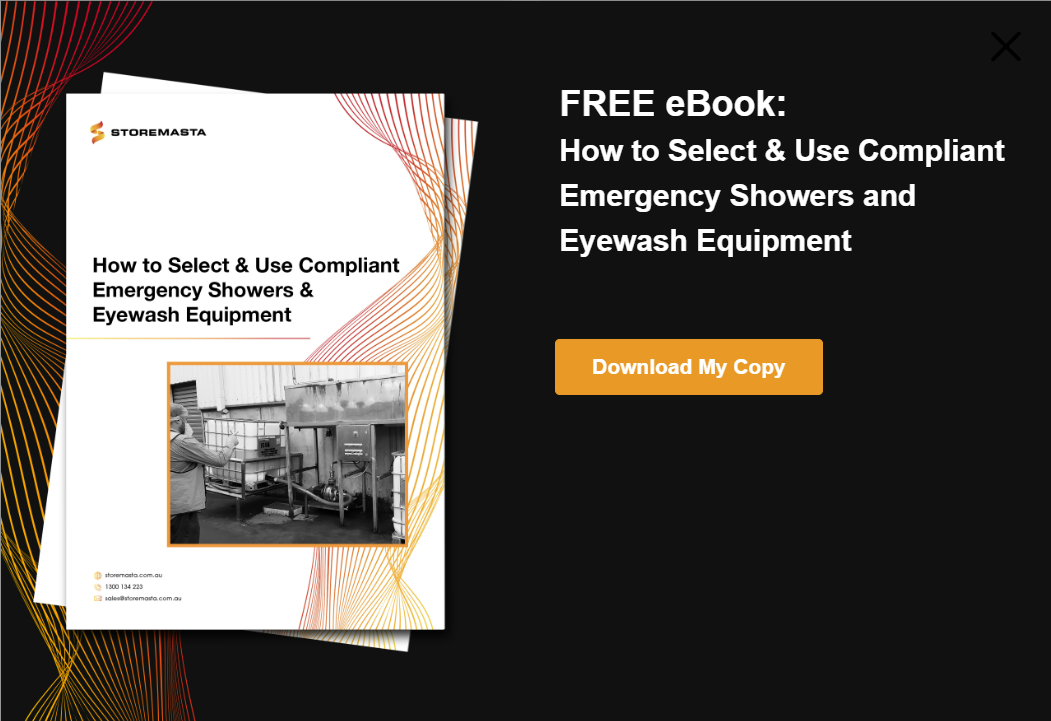For most businesses, the installation of emergency equipment is a necessary safety consideration. Afterall, a safety shower and eyewash station provide immediate decontamination for workers who may be exposed to hazardous chemicals, flying particles or even a workplace fire. In the event of exposure, the first 10 to 15 seconds after the incident is of critical importance. Choosing the right location for your decontamination equipment could be the difference between your staff making a complete recovery or retaining a serious injury. In this post, we’ll help you select a safe location for your emergency decontamination equipment through highlighting the eyewash and safety shower Australian Standard, as well as other key considerations.
IMPORTANT: In Australia, the installation of emergency decontamination equipment must comply with Australian Safety Standard AS 4775-2007 - Emergency eyewash and shower equipment.
Eyewash and Safety Shower Australian Standard
Referring to Australian Standards is the best place to start when installing an emergency shower or eyewash unit.
The overarching Standard AS 4775-2007 details the range of requirements that apply to the installation of your emergency decontamination equipment. We’ll look at these requirements in further detail below.
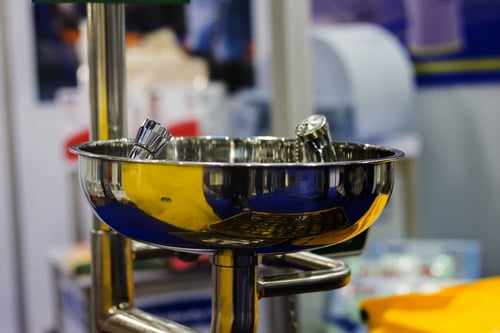
Refer to the Australian Standard for details on the eyewash and/or safety shower standards.
Accessibility
First, an emergency shower or eyewash station must be immediately accessible to staff in your workplace. The equipment be positioned on the same level as the hazard, and the path of travel to the equipment must be free of obstructions. This is to ensure that the eyewash or shower can be quickly utilised by staff before serious harm occurs due to chemical exposure.
Sometimes the best way to explain something is to demonstrate what NOT to do.
Therefore, consider the below points and make sure that workers DON’T have to do any of the following to access your eyewash or safety shower equipment:
- Climb up or down a ladder
- Open a cupboard, door, or gate
- Get past a partition or barrier
- Unlock something
- Move items out of the way
- Use stairs
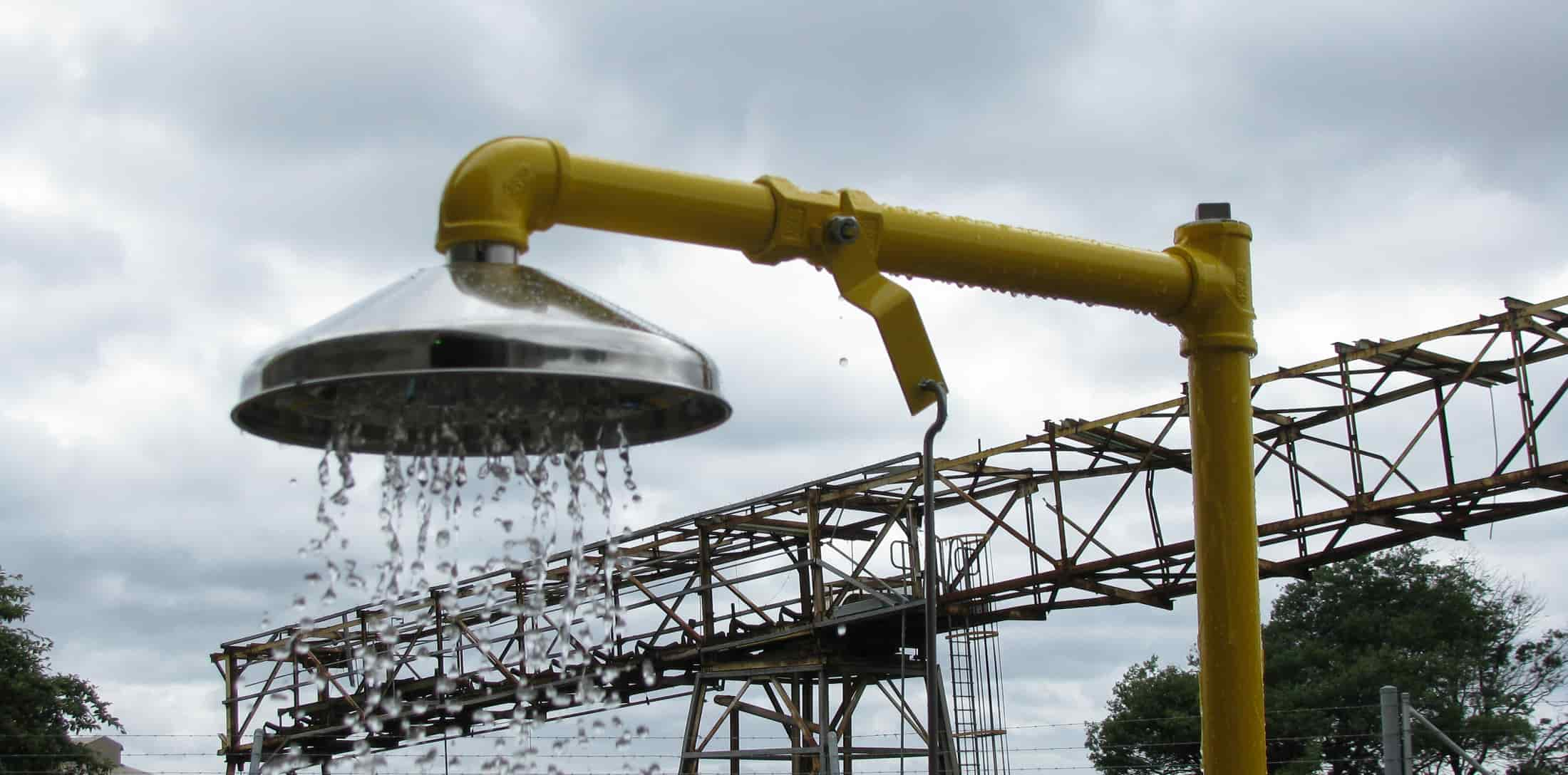
Install your eyewash station and/or safety shower in a convenient location on the same level as the hazard.
10 Second Rule
An injured worker must be able to reach the decontamination station within 10 seconds. So, when making your decision about where to locate the eyewash station and safety shower, you’ll need to consider where an injury could happen, as well as the condition of the worker.
An injured worker may need to be carried by co-workers, which will slow down the accessibility time.
REMEMBER: Any staff members who may be exposed to hazardous chemicals, must be trained in both the location of, and the correct use of, the emergency shower and eyewash.
Visibility
The overall visibility of a safety shower or eyewash station can impact the 10 second rule. If staff can’t quickly identify the location of the equipment after being exposed to hazardous chemicals, then they may be at risk of further damage to their health.
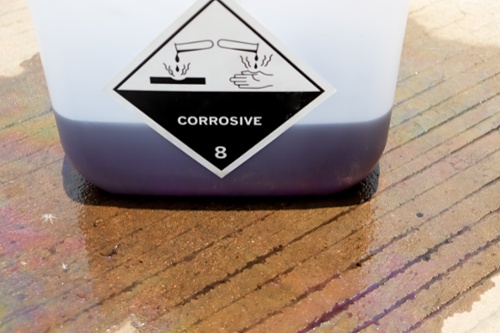
If hazardous substances make contact with the body, it’s vital that injured staff are able to locate emergency decontamination equipment within 10 seconds.
To assist injured staff in locating the units, the Standard requires that all eyewash stations and safety showers be highly visible, with signage including a warning placard.
The entire area served by the equipment must be properly illuminated. Keep in mind that a power cut or damage to a light fitting could potentially render the whole area unsafe and non-compliant. Therefore, install the emergency equipment in a position that benefits from multiple light sources.
Extreme Temperatures
To assist with the effectiveness of the equipment, the Standard also details further requirements if you’re situated in an environment that is prone to extreme temperature conditions. If you’re located in such an environment, the emergency decontamination equipment must be protected from the effects of the temperature extremes. This includes the ability of the equipment to operate properly, as well as the temperature of the flushing fluid.
Hazard Class Of Chemicals
Your next consideration will be the type of hazardous materials that you’re carrying. The dangerous goods class of your chemicals can also impact the location of your emergency decontamination equipment.
You should always check the hazard class of your chemical product by referring to the Safety Data Sheet.
You can then cross-reference this with the applicable Australian Standard to determine if you should carry out any of the following requirements:
- (Flammable liquids) AS 1940:2017 - The storage and handling of flammable and combustible liquids
- (Corrosives) AS 3780-2008 - The storage and handling of corrosive substances
- (Toxic substances) AS 4452-1997 - The storage and handling of toxic substances
- (Oxidisers) AS 4326-2008 - The storage and handling of oxidizing agents
- (Flammable Solids) AS 5026-2012 - The storage and handling of Class 4 dangerous goods
- (Organic Peroxides) AS 2714-2008 - The storage and handling of organic peroxides
For each of these chemical types, there is an Australian Standard with a location requirement (sometimes it’s a specific distance, sometimes it’s determined by a risk assessment).
For example: the Standard AS 3780-2008 requires showers and eyewash units within 7-10 metres of corrosive substances, but no closer than 2 metres. So, when deciding on the exact location of your equipment, you’ll need to consider how water from the decontamination equipment could react with the chemicals — or how the corrosives could contaminate or degrade the facilities.
REMEMBER: An eyewash or safety shower must be in a location where no further contamination could take place. The activation of the unit and release of flushing fluids must not be able to react dangerously with other chemicals or equipment stored in the area.
Nature Of Job Site
Finally, you should consider the nature of the job site, the profile of your workers and contractors, and the type of work you are undertaking. For example: the needs of a defence site with multiple workers that is off loading and dispensing aviation fuel will be different than a small workshop with 1-2 spray painters.
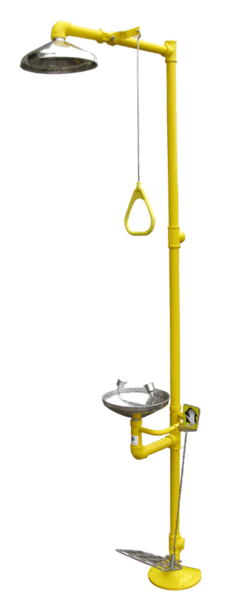 Combination safety shower and eyewash facilities are an all-in-one decontamination solution.
Combination safety shower and eyewash facilities are an all-in-one decontamination solution.
Some things to consider are when choosing the location of your decontamination equipment:
- Drainage system: what will happen to contaminated waste water? Could it get into drains or waterways and harm the environment? Could another worker or emergency responder become injured from the waste water?
- Number of workers: how many workers could have injuries all at the same time? Do you have enough units in place?
- Electrical equipment: could flushing fluid contact any electrical chords or equipment that becomes hazardous when wet?
- Climate: How could extreme weather patterns affect the temperature and usability of an eyewash or shower unit? Could the pipes freeze? Could the water become so hot it’s now unsafe for flushing?
- Disabled workers: do you have disabled workers or other personnel in wheelchairs who may need an eyewash or shower activation lever at a lower level?
- Privacy: in most chemical emergencies, workers must remove some of their clothing to wash off hazardous substances. Nearly all of us cringe at the thought of taking our clothes off in public, so consider how workers with cultural and gender sensitivities might be impacted by a shower unit in a high traffic area — in full view of the work floor?
IMPORTANT: Always consider the overall practicality of an emergency station. Is it easily accessible to emergency responders, ambulances, or rescue vehicles? Will work operations, vehicles, equipment interfere with ongoing treatment?
Like To Learn More About Safety Shower Standards?
While our post has highlighted some important considerations for selecting the best location for your emergency decontamination station, our team at STOREMASTA® recommend carrying out a risk assessment before purchasing any safety equipment. This will help you better understand the hazards in your workplace — and allow you to ensure a compliant installation for your eyewash stations and safety showers.
For a more detailed guide on emergency decontamination equipment, why not access our free eBook How To Select And Use Compliant Emergency Showers And Eyewash Equipment? Read our helpful guide today and take the next step in chemical safety compliance.
Joining the team as a Dangerous Goods Storage Consultant, Melissa Hampton became Storemasta's Marketing Manager in late 2021. With extensive knowledge and experience in chemical compliance, Melissa is responsible for leading the Marketing team and helping shape their marketing strategy. In her spare time, you can find Melissa hiking, swimming and enjoying the great outdoors in beautiful north-west Tasmania.
